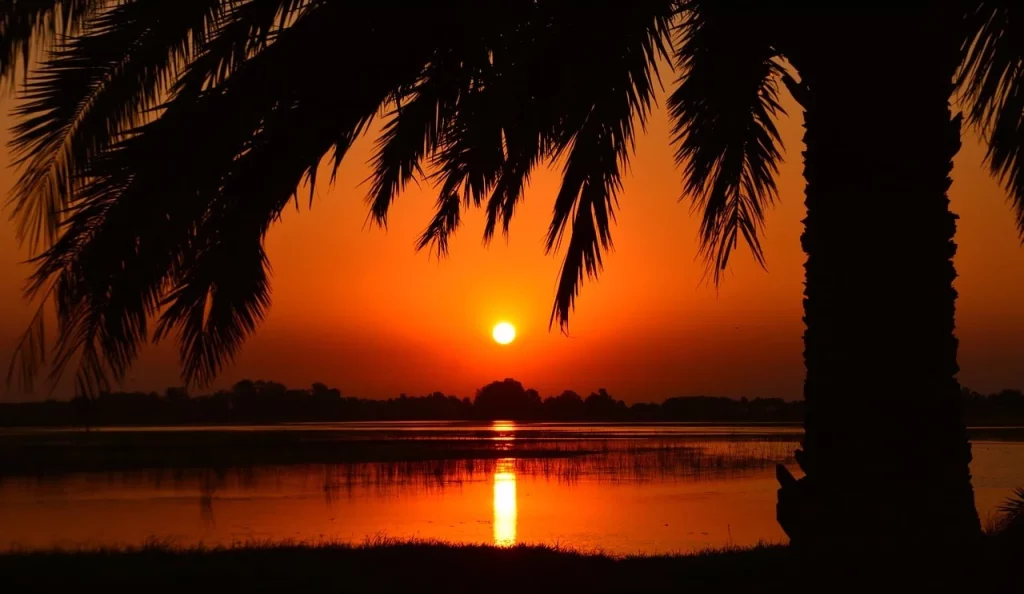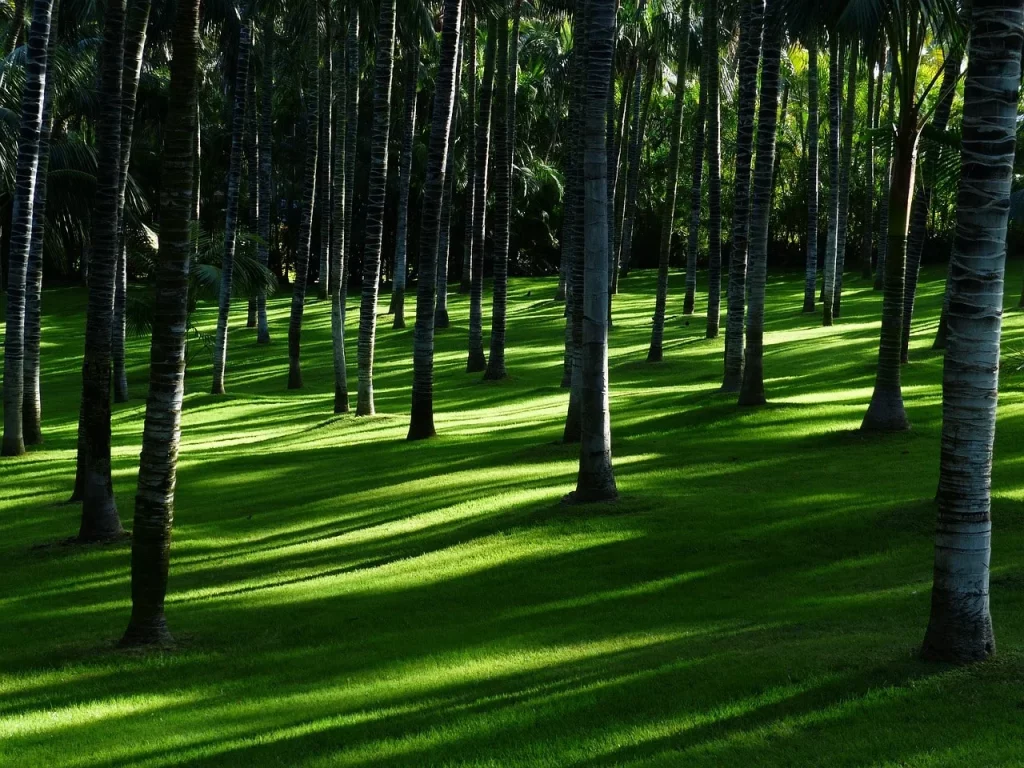When you think of palm trees, images of sunny beaches and tropical drinks might come to mind. But did you know there’s so much more to these trees than meets the eye?
In our exploration, we’ll uncover the extraordinary aspects of palm trees, shedding light on their environmental significance, surprising uses, and the diversity that exists within this fascinating group of plants.
Get ready to have your perception of palm trees transformed as we dive into their world, revealing facts that will astonish and delight you.
Under the palm trees is where I found peace.
Unknown
Palm Tree Facts
Before we dive into the fascinating world of palm trees, keep in mind that there’s a quiz waiting for you at the end of this article. Pay close attention to each detail if you’re aiming to prove your expertise.
- These plants can live for more than a century, with some species thriving for up to 200 years.
- Contrary to popular belief, they are not trees but rather a type of grass, belonging to the family Arecaceae.
- The tallest species, the wax palm, towers skywards, reaching heights of up to 197 feet (60 meters).
- Cocopalm seeds are the largest seeds in the plant kingdom, weighing up to 50 pounds (23 kilograms).
- They can survive in a variety of climates, from deserts to rainforests.
- A single plant can bear up to 6000 fruits per season, depending on the species.
- Their roots don’t grow deep underground but spread out near the soil surface.
- They play a crucial role in reducing greenhouse gases by absorbing carbon dioxide.
- Some species have adapted to grow in complete or partial saltwater, showcasing incredible versatility.
- Raffia fibers, obtained from certain species, are used to make ropes, baskets, and even textiles.
- The symbol of victory and peace in many cultures has often been depicted with these plants.
- More than 2,500 species exist worldwide, showcasing a vast diversity.
- The heart of some species is edible and considered a delicacy in many parts of the world.

- In some cultures, every part of the plant is utilized, embodying the principle of zero waste.
- Some species produce oils that are key ingredients in cosmetics, cooking, and even as biofuel.
- Dates, a sweet and nutritious fruit, come from the date palm, which has been cultivated by humans for over 5,000 years.
- They can withstand hurricanes and other severe storms, making them a resilient addition to any landscape.
- The leaves of some species are used in religious ceremonies and as symbolic decorations.
- Not all palms grow tall; some species are small enough to fit in a household pot.
- Leaf fossils discovered in China suggest that they have been around for at least 55 million years.
- Their seeds can travel vast distances across oceans, contributing to their spread across tropical and subtropical regions.
- Methuselah, a date palm grown from a 2,000-year-old seed, represents one of the most remarkable instances of seed viability.
- They are considered keystone species in many ecosystems, supporting a wide range of wildlife.
- Their flowers are usually small and unassuming, but they play a crucial role in the reproductive process.
- Some species are known to “walk” by growing new roots and letting old ones die, gradually moving to better sunlight.
- Their growth rate varies widely; some species grow rapidly, while others take decades to reach maturity.
- Historically, they have symbolized fertility, victory, and eternal life in various cultures.
- In the Middle Ages, they were so valuable in the Middle East and North Africa that they were used as currency.

- Their ability to store water in their trunks helps them survive in arid environments.
- The ancient Romans celebrated Palm Sunday by distributing branches to the populace, a tradition still observed in Christianity.
- Some species have been used for their medicinal properties, treating a variety of ailments.
- The Guinness World Record for the most expensive ever sold went to a species of this plant, fetching over $1 million.
- They are capable of self-pollination or cross-pollination, with some species relying on wind or insects for pollination.
- Sago palms, despite their common name, are not true palms but share similar appearances.
- Their sap can be fermented to produce palm wine, a popular beverage in various tropical regions.
- Environmental stress, such as salinity or drought, can induce them to flower, a survival mechanism to ensure reproduction.
- In several island nations, their leaves are traditionally used for roofing materials due to their durability and waterproof qualities.
- They are a vital source of nutrition and habitat for many animal species, including birds, insects, and mammals.

- The unique silhouette of palms is often associated with tropical paradises and leisure, influencing tourism and popular culture.
- Tagua nuts, also known as vegetable ivory, come from a palm species and are used to make buttons, jewelry, and other crafts.
- They serve as a natural windbreak, protecting coastlines and buildings from storm damage.
- Due to their longevity, some individual plants have become historic landmarks.
- Arecanut, derived from a specific species, is chewed with betel leaf and is an important cultural practice in many Asian countries.
- Many cities around the world use them to line streets and decorate parks, contributing to urban beauty and biodiversity.
- Their seeds’ germination process can be extremely slow, taking several months to several years to sprout.
- Despite their association with warm climates, some species are frost-tolerant and can survive in cooler temperatures.
- The Fibonacci sequence, a series of numbers significant in mathematics and nature, is evident in the arrangement of leaves on some palm species, showcasing a beautiful example of phyllotaxis.
- Palm oil, derived from the fruit of certain species, has become one of the world’s most controversial agricultural products due to environmental concerns over deforestation and habitat destruction.
- In ancient times, they were so revered that they were often planted near temples and are mentioned in various religious texts, symbolizing spiritual significance and sanctity.
- Despite their robust appearance, some species are critically endangered due to overharvesting, climate change, and disease, making the conservation of these iconic plants a global priority.
Palm Tree Myths

Now that we’ve explored all these fascinating facts about palm trees, it’s time to delve into another aspect: separating the truth from myth. Let’s uncover the realities behind the common misconceptions.
- Palm Trees Are Only Tropical
They are often thought to be exclusive to tropical regions. However, many varieties can thrive in a wide range of climates, including deserts and even places with mild, cold weather. Some species have been known to withstand frost and cold temperatures surprisingly well. - Palm Trees Can Only Grow Near The Ocean
While they are iconic in coastal landscapes, they are not limited to seaside environments. They can be cultivated successfully far from the coast in a variety of soil types and environments, as long as their specific water and sunlight needs are met. - All Palm Trees Produce Coconuts
This is a common misconception. In reality, only specific species of palm trees, such as the coconut palm (Cocos nucifera), bear coconuts. There are over 2,500 species of palm trees, and most do not produce coconuts or any similar fruit. - Palm Trees Grow Fast
The growth rate varies widely among the different species. Some palms can grow rapidly, while others grow very slowly. The Royal Palm can shoot up to impressive heights relatively quickly, whereas the Sago Palm grows slowly and can take years to reach full size. - Palm Trees Are Easy to Maintain
While it’s true that many palm species are low-maintenance, they do have specific care requirements that must be met. Proper fertilization, watering, and sometimes pruning are necessary to keep them healthy. Neglecting these requirements can lead to poor health or even the death of the palm tree.
No products found.
Palm Tree Quotes

In this section, we’ll dive into quotes that capture the essence of these majestic trees, exploring their connection to relaxation, resilience, and the beauty of island life.
A palm tree stands in the desert, but the desert knows not the palm tree.
Khalil Gibran
In this poetic reflection, Gibran contemplates the isolation and resilience of the palm tree, symbolizing perseverance and solitude in adversity.
The palm tree that sways in the breeze stays standing the longest.
Hawaiian Proverb
This Hawaiian proverb uses the palm tree as a metaphor for flexibility and resilience, suggesting that adaptability leads to longevity.
The cool shade of the palm is a blessing to the weary traveler.
African Proverb
Highlighting the palm tree as a source of relief and comfort in harsh conditions, this African proverb appreciates its role in providing shelter and respite.
Palm trees were once warriors of the sea, born from the heart of ocean tempests.
Pavana Reddy
Pavana Reddy draws a vivid image of palm trees’ origins, portraying them as embodiments of strength and resilience, having emerged from the chaos of the sea.
To the artist, the palm tree is a towering symbol of grace and elegance.
Unknown
This quote reflects on the aesthetic beauty of the palm tree, admired for its slender form and graceful fronds, making it a subject of artistic inspiration.
Palm Tree FAQ

As we dive into the final section before your quiz, keep the essence of palm trees in mind. These quotes were just the beginning; now, let’s sharpen your knowledge with our FAQs. Read carefully; your quiz’s success depends on it.
- Why do palm tree leaves turn yellow?
Yellowing leaves can signal a few issues, like nutrient deficiencies (especially magnesium or nitrogen), underwatering, or poor soil drainage. It’s like the tree is waving a little yellow flag, asking for help with its living conditions! - Can palm tree roots damage pipes?
Their roots are generally not as invasive as those of other trees, but they can still cause trouble if they’re planted too close to pipes or sewer lines. These roots seek moisture and can find their way into cracks, so it’s like they’re curious explorers that sometimes wander where they shouldn’t! - Are palm tree leaves poisonous to dogs?
Most palm tree leaves are not poisonous to dogs, but it’s always better to be cautious. Certain types, like the sago palm, are highly toxic and can be dangerous if ingested. Think of palm leaves like a mixed bag of treats, where most are fine but a few need to be avoided. - Can palm trees survive the winter?
Yes, some can survive the winter, especially those in the more temperate zones. It’s all about choosing the right type of palm. There are even palms that can withstand snow! It’s as if some palms have their own little winter coats, ready for the cold. - Are palm trees native to California?
While they have become symbolic of California’s sunny landscape, most varieties were introduced from elsewhere. The California Fan Palm is the only palm native to the state, standing out as a true Californian among the transplants and enjoying the West Coast lifestyle from the start!
No products found.
Palm Tree Trivia

Welcome to our tropical quiz on palm trees, where the stakes are as high as a coconut in a tall palm. Get ready, because if you don’t nail at least one question, you might just find yourself stranded on a deserted island, talking to a volleyball for company!
Conclusion
It’s clear that palm trees do much more than provide a backdrop for stunning sunsets. They’re a vital part of ecosystems, offering sustenance and shelter to numerous species.
They embody the spirit of survival, growing in some of the most challenging environments. Their contribution to human life, from food to cultural practices, cannot be understated. As we continue to learn from and with them, let’s protect and cherish these magnificent trees.
Let’s close this one with a funny question: If you were to organize a party for palm trees, what would be on the playlist? “Leaf It All Behind” by The Branches? Let me know in the comments.


